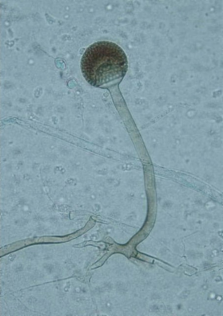Rhizopus microsporus
Rhizopus microsporus is a species of fungus in the genus Rhizopus. It is known for its role in food spoilage, plant pathology, and as an opportunistic pathogen in humans. This species is also notable for its use in the production of certain fermented foods.
Taxonomy and Classification[edit | edit source]
Rhizopus microsporus belongs to the kingdom Fungi, phylum Zygomycota, class Zygomycetes, order Mucorales, and family Mucoraceae. It is closely related to other species within the genus Rhizopus, such as Rhizopus stolonifer.
Morphology[edit | edit source]
Rhizopus microsporus is characterized by its hyphae, which are typically non-septate and can grow rapidly. The sporangia are spherical and contain numerous sporangiospores. The sporangiophores are unbranched and arise from the rhizoids.
Ecology and Habitat[edit | edit source]
This fungus is commonly found in soil, decaying organic matter, and various food products. It thrives in warm and humid environments, making it a frequent contaminant in tropical and subtropical regions.
Pathogenicity[edit | edit source]
Rhizopus microsporus is an opportunistic pathogen that can cause zygomycosis in humans, particularly in immunocompromised individuals. It can also infect plants, leading to diseases such as soft rot in fruits and vegetables.
Industrial and Food Applications[edit | edit source]
In some cultures, Rhizopus microsporus is used in the production of traditional fermented foods. For example, it is involved in the fermentation process of tempeh, a popular Indonesian food made from soybeans.
Life Cycle[edit | edit source]
The life cycle of Rhizopus microsporus includes both asexual and sexual reproduction. Asexually, it reproduces through the formation of sporangia that release sporangiospores. Sexually, it forms zygospores through the fusion of specialized hyphae from compatible mating types.
Control and Prevention[edit | edit source]
Controlling the spread of Rhizopus microsporus involves maintaining proper hygiene and storage conditions, especially in food production and healthcare settings. Antifungal treatments may be necessary for infections in humans.
See Also[edit | edit source]
References[edit | edit source]
External Links[edit | edit source]
Search WikiMD
Ad.Tired of being Overweight? Try W8MD's NYC physician weight loss.
Semaglutide (Ozempic / Wegovy and Tirzepatide (Mounjaro / Zepbound) available. Call 718 946 5500.
Advertise on WikiMD
|
WikiMD's Wellness Encyclopedia |
| Let Food Be Thy Medicine Medicine Thy Food - Hippocrates |
Translate this page: - East Asian
中文,
日本,
한국어,
South Asian
हिन्दी,
தமிழ்,
తెలుగు,
Urdu,
ಕನ್ನಡ,
Southeast Asian
Indonesian,
Vietnamese,
Thai,
မြန်မာဘာသာ,
বাংলা
European
español,
Deutsch,
français,
Greek,
português do Brasil,
polski,
română,
русский,
Nederlands,
norsk,
svenska,
suomi,
Italian
Middle Eastern & African
عربى,
Turkish,
Persian,
Hebrew,
Afrikaans,
isiZulu,
Kiswahili,
Other
Bulgarian,
Hungarian,
Czech,
Swedish,
മലയാളം,
मराठी,
ਪੰਜਾਬੀ,
ગુજરાતી,
Portuguese,
Ukrainian
Medical Disclaimer: WikiMD is not a substitute for professional medical advice. The information on WikiMD is provided as an information resource only, may be incorrect, outdated or misleading, and is not to be used or relied on for any diagnostic or treatment purposes. Please consult your health care provider before making any healthcare decisions or for guidance about a specific medical condition. WikiMD expressly disclaims responsibility, and shall have no liability, for any damages, loss, injury, or liability whatsoever suffered as a result of your reliance on the information contained in this site. By visiting this site you agree to the foregoing terms and conditions, which may from time to time be changed or supplemented by WikiMD. If you do not agree to the foregoing terms and conditions, you should not enter or use this site. See full disclaimer.
Credits:Most images are courtesy of Wikimedia commons, and templates, categories Wikipedia, licensed under CC BY SA or similar.
Contributors: Prab R. Tumpati, MD

